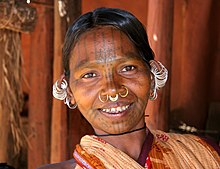Khonds: Difference between revisions
Template link updated: Template:Scheduled tribes in Odisha |
|||
| Line 24: | Line 24: | ||
{{Scheduled tribes of India}} |
{{Scheduled tribes of India}} |
||
{{Scheduled tribes in |
{{Scheduled tribes in Odisha}} |
||
[[Category:Indigenous peoples of India]] |
[[Category:Indigenous peoples of India]] |
||
Revision as of 16:01, 26 February 2013

Khonds, or Kandhs (Odia: କନ୍ଧ) are an aboriginal tribe of India, inhabiting Odisha and the Srikakulam and Visakhapatnam districts of Andhra Pradesh. Their main divisions are into Kutia, or hill Khonds and plain-dwelling Khonds; the landowners are known as Raj Khonds. They are hunter gatherers. They go out for collective hunts eating the fruits and roots they collect. They usually cook food with oil extracted from sal and mahua seeds. They also use medicinal plants. These practices make them mainly dependent on forest resources for survival. Their religion is animistic, and their pantheon includes eighty-three gods. The Kandhamal district in Odisha (erstwhile a part of Angul district), has a 55% Kandha population, and was named after the tribe. The Khond language, Kui, is more closely related to Telugu than is Gondi.
The Khonds became notorious on the British occupation of their district about 1835 for the prevalence and cruelty of the human sacrifices they practiced. These Meriah sacrifices were intended to further the fertilization of the earth. It was incumbent on the Khonds to purchase their victims. Unless bought with a price they were not deemed acceptable. They seldom sacrificed Khonds, though in hard times Khonds were obliged to sell their children and they could then be purchased as Meriahs. Persons of any race, age or sex were acceptable if purchased. Many were bought and kept and well treated. Meriah women were encouraged to become mothers.Some of the major groups derived from the principal professions they follow or the crafts they practice, for example, the cattle-breeding group takes the significant name of Gawli, derived from a Sanskrit word for cow. The names of the shepherd castes seem to be derived from words meaning sheep. Such is at least the case with Gadaria from 'gadar', on old Hindi word for sheep. Many others of these major groups called castes bear merely tribal or ethnic names. Such are for example: Arora, Gujjar, Lohana, Bhatia, Meena, Bhil, Dom, Oraon, Munda, Santal, Koch, Ahir, Mahar, Nayar, Maratha, Gond, Khond, etc.[1]
The Kondhs, or the Kui as they are locally known, are the largest tribal group in Odisha. They are known for their cultural heritage and values which center on respecting nature. Amongst the kondhs, Maliah Kondhs are the majority group and their spoken dialect 'Kui' language is Dravidian and spoken with only slight regional variations.
Their physical attributes are characterised by strength and symmetry. There skin colour ranges from light bamboo to a deep copper shade, the heel in a line with back of the leg. As regards their character, the Kandhas possess a great love for liberty. Kutia Kondhs another tribe dwells in remote hills in the extreme south-west of Kondhmal district.
Dongria Kondhs inhabit the steep slopes of the Niyamgiri Range of Koraput district and over the border into Kalahandi. They work entirely on the steep slopes for their livelihood. The Niyamgiri Range provides a wealth of perennial springs and streams which greatly enrich Dongria cultivation.
Kuvi speaking people reside in the villages that spread widely over the hills and valleys of north Koraput district. Kuvi is extremely nasal form of the Kondh language and also contains a few Telugu words, being alongside the state of Andhra Pradesh.
References
- ^ G.S. Ghurye, Caste And Race In India, Popular Prakashan, 2004 reprint, pages 31-33.
External links
- This article incorporates text from a publication now in the public domain: Chisholm, Hugh, ed. (1911). Encyclopædia Britannica (11th ed.). Cambridge University Press.
{{cite encyclopedia}}: Missing or empty|title=(help)
